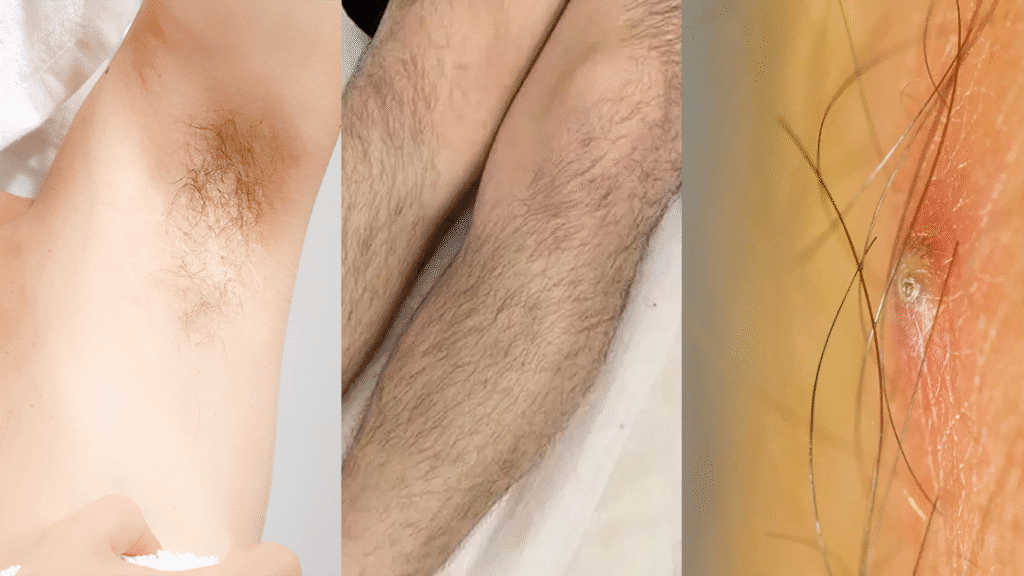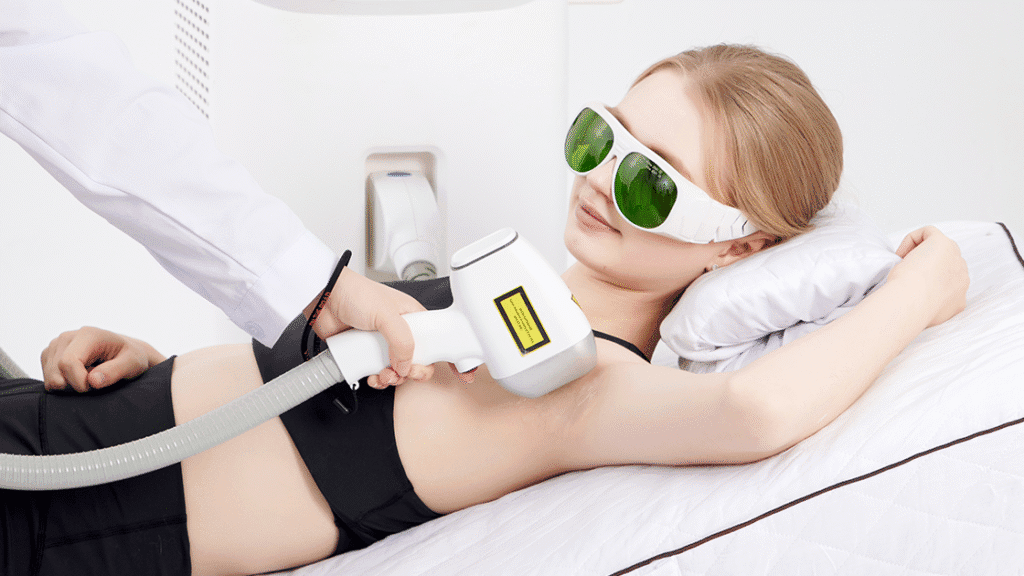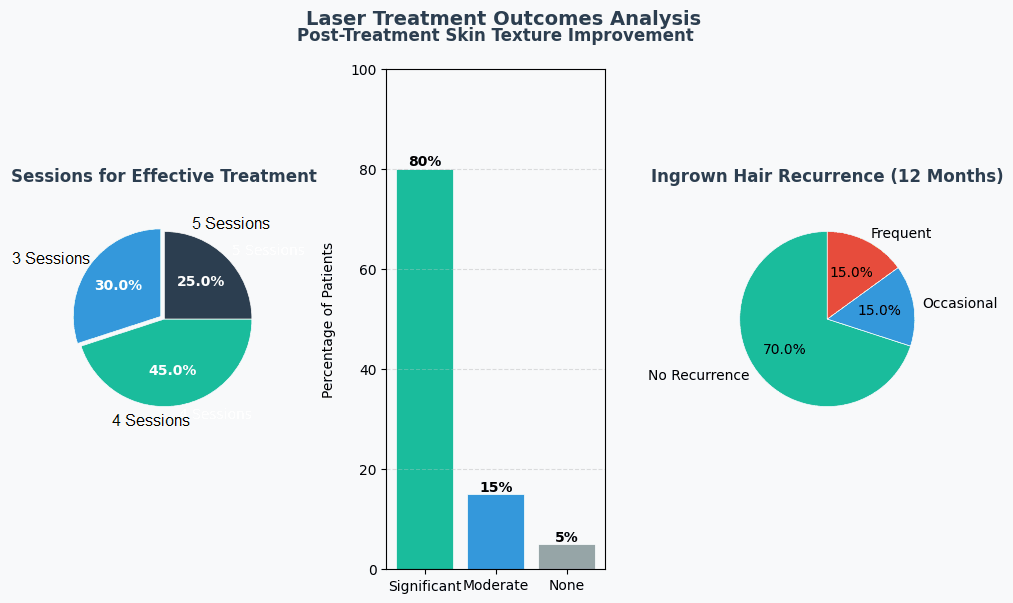Ingrown hairs are a common and often frustrating issue that many people face, causing discomfort, irritation, and sometimes even scarring. Fortunately, laser hair removal offers a solution that is both effective and long-lasting. This article delves into the causes of ingrown hairs, the traditional methods used for their treatment, and how laser hair removal can provide a permanent solution. With the backing of scientific understanding, patient experiences, and expert opinions, you’ll discover why laser hair removal could be the game-changer you’ve been looking for.
1. The Root of Ingrown Hairs
1.1 What Are Ingrown Hairs?
Ingrown hairs occur when a hair that has been shaved, waxed, or plucked grows back into the skin instead of out of the follicle. They can result in a raised, red bump or even lead to cysts in more severe cases. This problem often arises after the hair is cut off below the skin’s surface, causing it to become trapped in the follicle. According to the American Academy of Dermatology, ingrown hairs are more common in individuals with curly or coarse hair, as these types of hair have a higher tendency to curl back into the skin.
1.2 Symptoms and Signs of Ingrown Hairs
The signs of ingrown hairs can vary, but common symptoms include:
- Red, raised bumps: These are often the first sign of an ingrown hair.
- Pain or tenderness: When the hair becomes trapped beneath the skin, it may cause discomfort or a burning sensation.
- Pus-filled pustules: In more severe cases, ingrown hairs can lead to infection, resulting in pus-filled cysts.
- Hyperpigmentation: If left untreated, ingrown hairs can cause dark spots or scarring on the skin.
In general, ingrown hairs are most commonly found in areas where hair removal procedures like shaving, waxing, or tweezing are frequently done—such as the face, neck, underarms, legs, and bikini area.
1.3 Why Ingrown Hairs Keep Coming Back
Ingrown hairs tend to recur for several reasons. The main culprit is improper hair removal methods. Shaving, for example, can cause hair to be cut too short, leading it to curl back into the skin. Waxing and tweezing also disrupt the hair’s natural growth pattern, creating conditions where the hair becomes trapped. Additionally, factors such as thick, curly hair or the presence of excess skin can exacerbate the problem, leading to frequent flare-ups of ingrown hairs.
1.4 The Role of Genetics in Ingrown Hairs
Genetics plays a significant role in the development of ingrown hairs. People with naturally curly or coarse hair are more prone to experiencing ingrown hairs due to the way their hair grows. The hair may have a greater tendency to curl back towards the skin after being cut, causing it to become trapped. Furthermore, some individuals may have thicker skin or more tightly packed hair follicles, making it harder for hair to grow out properly.

2. Traditional Methods for Treating Ingrown Hairs
2.1 Shaving and Tweezing
Shaving and tweezing are the most common methods of hair removal, but both can contribute to the formation of ingrown hairs. When shaving, the razor cuts the hair at an angle, which can cause the hair to grow back into the skin. Tweezing, while effective at removing the hair, can cause trauma to the hair follicle, leading to irritation and the potential for ingrown hairs.
2.2 Over-the-Counter Treatments and Topicals
Several over-the-counter creams and treatments claim to reduce the occurrence of ingrown hairs. These products typically contain salicylic acid, glycolic acid, or benzoyl peroxide, which work by exfoliating the skin and helping to prevent hairs from becoming trapped. While these products may offer temporary relief, they do not address the root cause of ingrown hairs—hair growth patterns.
2.3 Medical Interventions
In more severe cases, medical interventions like corticosteroid injections or laser treatments may be necessary to treat ingrown hairs effectively. These treatments target the underlying issues, such as inflammation, infection, and hair follicle blockage. However, these methods can be costly and often require multiple sessions.
3. How Laser Hair Removal Works for Ingrown Hairs
3.1 How Lasers Target Hair Follicles
Laser hair removal is an advanced method of hair removal that works by targeting the pigment in the hair follicle. The laser emits concentrated light that is absorbed by the melanin (pigment) in the hair. This light is converted into heat energy, which damages the hair follicle, effectively hindering hair growth. Over several sessions, the targeted hair follicles are destroyed, leading to permanent hair removal. The precision of laser technology allows it to selectively target hair follicles without causing damage to the surrounding skin. This is particularly beneficial for individuals who suffer from ingrown hairs, as the laser can eliminate problematic follicles and prevent new hairs from growing in abnormal directions.
3.2 Photothermal Effect: Turning Light into Heat
The principle behind laser hair removal is the photothermal effect, where light energy is absorbed by the melanin in the hair follicle and converted into heat. This heat then damages the follicle, preventing future hair growth. The effectiveness of this process depends on the contrast between the hair color and the skin tone—darker hair absorbs more light, making it more responsive to laser treatment.
3.3 The Hair Growth Cycle and Laser Timing
Laser hair removal is most effective during the anagen (growth) phase of the hair cycle. During this phase, the hair is firmly anchored in the follicle, allowing the laser to effectively target and damage the follicle. Since not all hairs are in the anagen phase at the same time, multiple sessions are needed to ensure that all hair follicles are treated.

4. The Benefits of Laser Hair Removal for Ingrown Hairs
4.1 Long-Term Ingrown Hair Prevention
Laser hair removal offers a permanent solution to ingrown hairs. By targeting and disabling hair follicles, laser treatment can prevent new hairs from growing back and becoming trapped beneath the skin. Over time, patients will experience fewer and fewer ingrown hairs, leading to smoother, irritation-free skin.
4.2 Faster Recovery and Less Irritation
Unlike traditional hair removal methods, which can lead to immediate irritation, redness, and post-treatment bumps, laser hair removal typically results in less skin irritation. The non-invasive nature of laser treatment reduces the risk of infection or scarring, and recovery times are usually quick.
4.3 Precision Treatment for Problem Areas
Laser hair removal allows for precision treatment of areas most prone to ingrown hairs, such as the bikini line, underarms, and neck. The targeted nature of the laser ensures that only problematic hair follicles are treated, leaving surrounding skin unharmed.
4.4 Improved Skin Texture and Tone
By eliminating hair follicles that cause ingrown hairs, laser treatment can improve the overall texture and tone of the skin. The removal of trapped hair reduces inflammation and irritation, leading to smoother, more even skin.
4.5 Effective for All Skin and Hair Types
Laser technology has evolved to accommodate a wide range of skin tones and hair types. While earlier versions of laser hair removal were most effective on individuals with light skin and dark hair, newer technologies such as Nd:YAG lasers allow for safe and effective treatment for people with darker skin tones and lighter hair.
4.6 Minimal Maintenance Required
After the initial treatment sessions, laser hair removal typically requires minimal maintenance. While some hair may regrow after a few years, it tends to be finer and lighter, making it less noticeable and less prone to ingrown hairs. Touch-up treatments may be necessary for some patients, but the overall maintenance is significantly lower compared to traditional hair removal methods.
4.7 Boost in Self-Confidence and Comfort
For individuals who have struggled with the discomfort and embarrassment of ingrown hairs, laser hair removal can be a transformative experience. By providing a permanent solution to a common issue, it can boost self-confidence and comfort, allowing people to enjoy smoother, hair-free skin without the constant worry of ingrown hairs.

5. Patient Experiences from Laser Hair Removal for Ingrown Hairs
5.1 Testimonials from Patients
For many people, laser hair removal isn’t just about aesthetics—it’s a relief from chronic skin irritation.
- Sarah, a 34-year-old teacher, dealt with painful ingrown hairs on her legs for years: “Shaving always left me with inflamed bumps and dark marks. After six sessions of laser hair removal, the ingrown hairs are gone, and my skin feels smoother than ever.”
- Mark, 41, had issues along his neckline from daily shaving: “It looked like a breakout every morning. Laser treatment didn’t just fix the ingrown hairs—it improved my confidence at work.”
These firsthand stories show the dramatic difference laser hair removal can make for people who’ve exhausted other options.
5.2 Expert Opinions on Laser Hair Removal for Ingrown Hairs
Medical professionals widely agree: laser hair removal is one of the most reliable long-term solutions for ingrown hairs.
- Dr. Emily Thompson, board-certified dermatologist, explains: “Laser energy selectively targets melanin in the hair follicle, damaging it to prevent regrowth. This removes the root cause of ingrown hairs—literally.” She adds that it’s especially helpful in areas prone to irritation, like the bikini line, beard zone, and underarms.
- Dr. Michael Chen, a laser specialist, highlights advancements in technology: “Newer diode and Alexandrite lasers can treat a variety of skin tones safely. For patients with coarse or curly hair—often most at risk for ingrowns—this is a game-changer.”
With expert guidance, laser treatment becomes not just a cosmetic fix but a dermatologically sound approach to long-term skin health.
5.3 Success Rate and Long-Term Benefits
The success rate of laser hair removal for ingrown hairs is consistently high—often over 85% with proper treatment intervals. A 2022 clinical study published in the Journal of Cosmetic Dermatology reported that 88% of patients experienced “marked improvement” in ingrown hair frequency after four sessions.
Long-term benefits include:
- Lasting prevention of new ingrown hairs
- Smoother skin with reduced scarring and hyperpigmentation
- Fewer flare-ups, leading to less need for creams, tweezers, or dermatology visits
By targeting the follicle, laser therapy provides a sustainable solution—less maintenance, fewer breakouts, and better skin overall.
6. Who Can Benefit from Laser Hair Removal for Ingrown Hairs?
6.1 Identifying the Right Candidates for Laser Treatment
Laser hair removal is most beneficial for individuals who frequently experience ingrown hairs and are looking for a long-term solution. People with darker, coarser hair are typically better candidates for laser hair removal, as the laser technology works by targeting the pigment in the hair follicle. However, advances in technology have made it possible for individuals with darker skin tones to undergo treatment as well. If you have been struggling with ingrown hairs on areas like the bikini line, neck, or underarms and other methods haven’t provided lasting relief, laser hair removal might be an ideal option for you. Additionally, those who are looking for smoother skin with reduced risk of post-treatment scarring can benefit from the precision of laser treatment.
6.2 Special Considerations for Sensitive Areas
Certain areas of the body, like the bikini line, underarms, and face, are particularly prone to ingrown hairs and require extra care when it comes to laser hair removal. These sensitive areas are often more reactive to irritation, so it is crucial that laser technicians adjust the laser settings to ensure safety and comfort. Patients should consult with a trained and certified laser specialist to ensure that the right settings and techniques are used for sensitive areas. Proper aftercare is also important to reduce any risk of irritation or side effects following treatment.
6.3 Age and Health Factors in Laser Hair Removal for Ingrown Hairs
Age and overall health are essential factors to consider when determining whether laser hair removal is suitable. While there is no strict age limit for laser hair removal, it is typically recommended for individuals aged 18 and older. People under 18 may not be ideal candidates since their hair growth patterns are still developing. It is also important to discuss any health conditions with a laser specialist before undergoing treatment. Individuals with certain skin conditions, active infections, or those who are pregnant may not be suitable candidates for laser hair removal. A thorough consultation can help ensure that any potential risks are minimized.
6.4 Conditions That May Affect Suitability
Certain medical conditions or medications can affect the safety and effectiveness of laser hair removal. Conditions like eczema, psoriasis, or lupus may increase sensitivity to treatments. Medications that heighten photosensitivity, such as antibiotics or Accutane, require caution. People with darker skin or light hair were previously discouraged from laser hair removal due to safety concerns. However, recent advancements have made the treatment safer for these individuals. Always consult a trained professional to assess your skin type, hair type, and medical history before proceeding with laser hair removal.
7. Summary and Final Thoughts
Laser hair removal offers a permanent, effective solution for those struggling with the discomfort and recurrence of ingrown hairs. With its precision targeting of hair follicles, minimal side effects, and long-term results, laser hair removal stands out as the ideal choice for ingrown hair treatment. If you’re tired of dealing with the pain and irritation of ingrown hairs, consulting with a certified specialist to explore laser treatment could be the best decision for smoother, hair-free skin.








